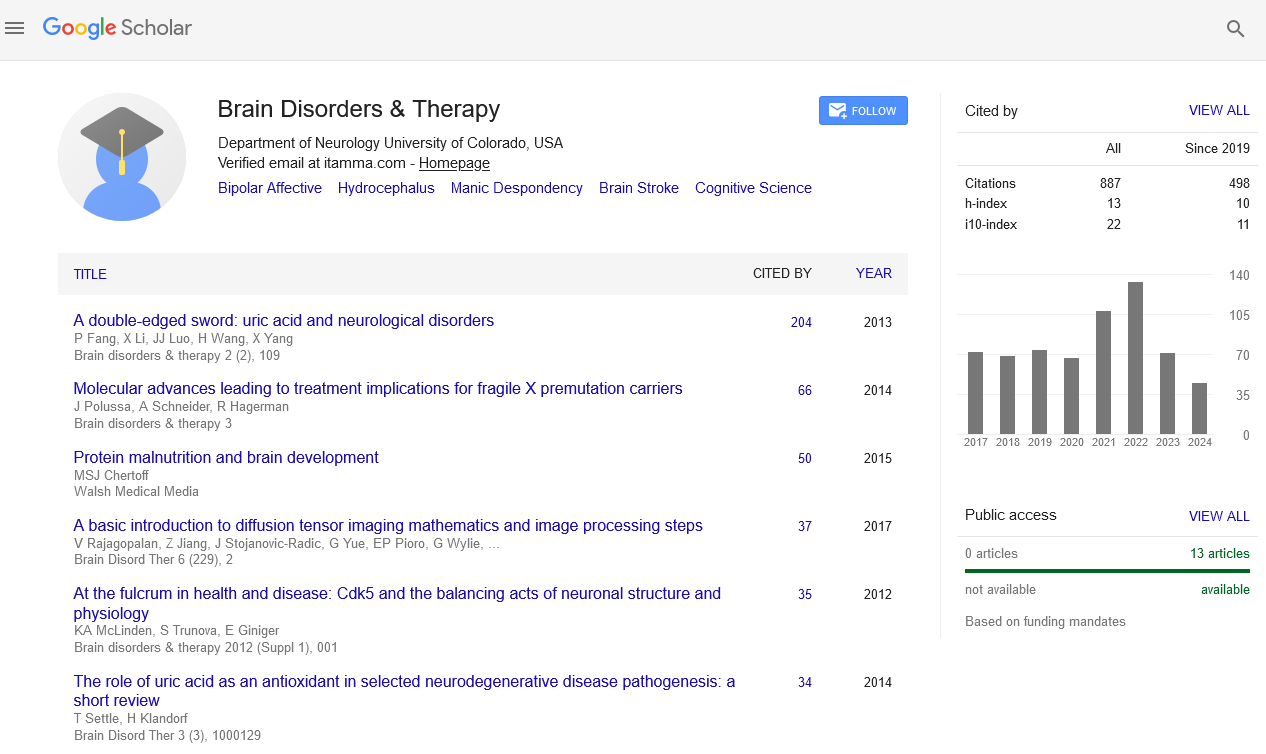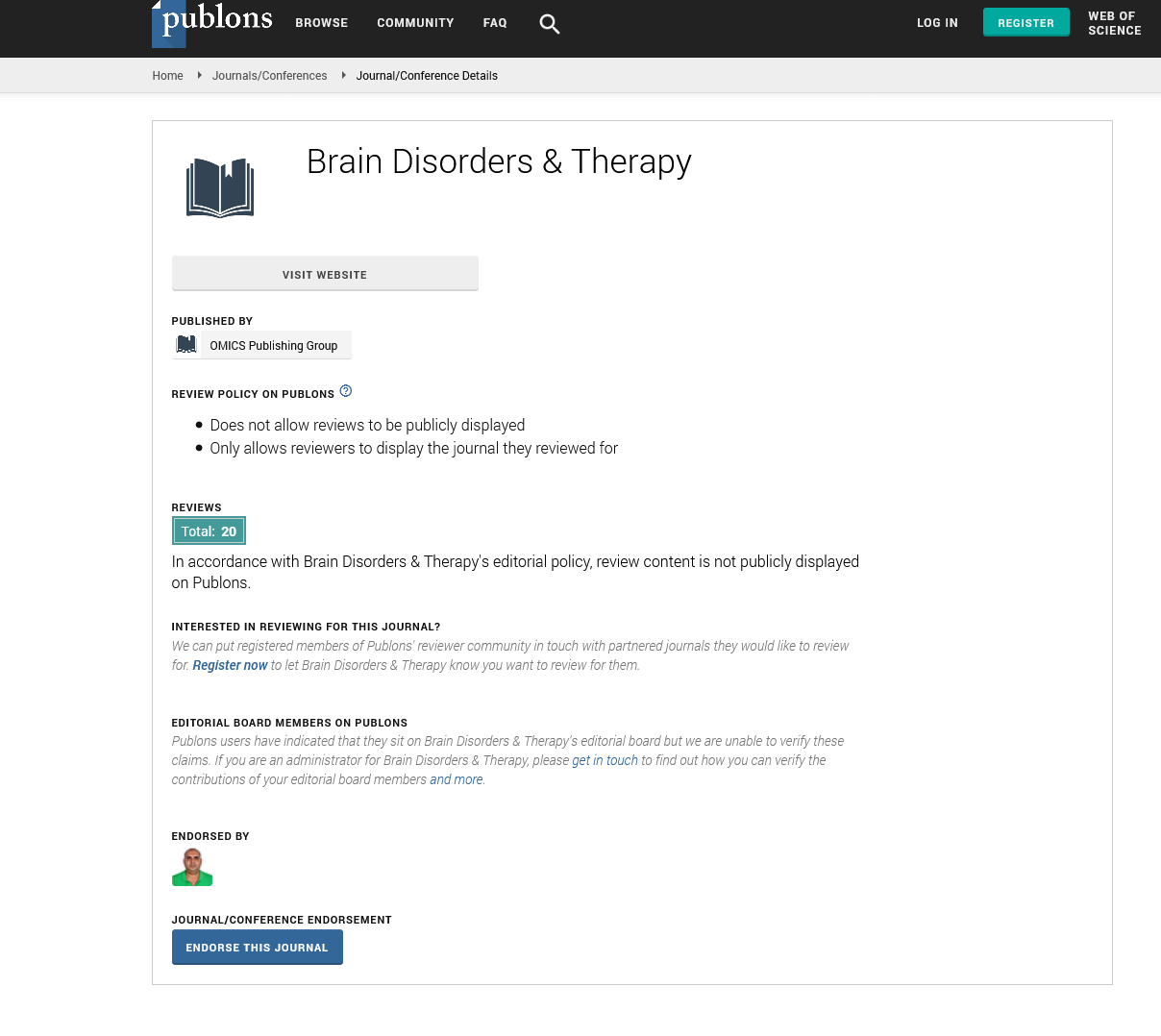Indexed In
- Open J Gate
- Genamics JournalSeek
- JournalTOCs
- RefSeek
- Hamdard University
- EBSCO A-Z
- OCLC- WorldCat
- Publons
- Geneva Foundation for Medical Education and Research
Useful Links
Share This Page
Journal Flyer

Open Access Journals
- Agri and Aquaculture
- Biochemistry
- Bioinformatics & Systems Biology
- Business & Management
- Chemistry
- Clinical Sciences
- Engineering
- Food & Nutrition
- General Science
- Genetics & Molecular Biology
- Immunology & Microbiology
- Medical Sciences
- Neuroscience & Psychology
- Nursing & Health Care
- Pharmaceutical Sciences
Commentary - (2024) Volume 13, Issue 4
Potential of Baseline Serum Glutamate in Alzheimer's Disease Diagnosis and Prognosis
Ying Zhan*Received: 22-Nov-2024, Manuscript No. BDT-24-27652; Editor assigned: 25-Nov-2024, Pre QC No. BDT-24-27652(PQ); Reviewed: 09-Dec-2024, QC No. BDT-24-27652; Revised: 16-Dec-2024, Manuscript No. BDT-24-27652(R); Published: 23-Dec-2024, DOI: 10.35248/2168-975X.24.13.279
Description
Alzheimer’s Disease (AD) remains a major global health challenge, with its prevalence expected to rise as populations age. Early diagnosis and accurate prediction of disease progression are essential for developing effective therapeutic strategies and improving patient outcomes. Mild Cognitive Impairment (MCI), often considered a prodromal stage of Alzheimer’s, offers a critical window for intervention. However, distinguishing MCI from normal aging and predicting its progression to AD remain significant clinical hurdles. Emerging research suggests that baseline serum glutamate levels could serve as a biomarker, providing valuable insights into the pathophysiology of Alzheimer’s and aiding in its diagnosis and prognosis.
The Alzheimer’s Disease Neuroimaging Initiative (ADNI), a landmark study aimed at identifying biomarkers for early AD detection, has highlighted the potential role of glutamate a major excitatory neurotransmitter in the brain in neurodegenerative processes. Dysregulation of glutamate signaling has been implicated in synaptic dysfunction, neuronal loss and cognitive decline, all characteristic features of Alzheimer’s pathology. By exploring the relationship between baseline serum glutamate levels, MCI and AD, researchers aim to uncover new avenues for diagnosis and prediction.
Glutamate plays a central role in synaptic transmission and plasticity, processes essential for learning and memory. In a healthy brain, its levels are tightly regulated to ensure optimal neuronal communication. However, disruptions in glutamate homeostasis can lead to excitotoxicity a pathological condition where excessive glutamate overstimulates neurons, causing cell damage and death. This excitotoxicity has been linked to Amyloid-Beta (Aβ) plaques and tau tangles, the primary pathological markers of AD.
In the early stages of MCI, subtle changes in glutamate signaling may already be underway, even before significant cognitive symptoms manifest. These changes could reflect underlying synaptic dysfunction, setting the stage for more pronounced neurodegeneration as the disease progresses. Measuring serum glutamate levels at baseline provides a non-invasive way to assess these early disruptions, offering a potential biomarker for identifying individuals at risk of progressing to AD.
The ADNI has provided valuable data on serum glutamate levels across individuals with normal cognition, MCI and AD. Preliminary findings suggest that serum glutamate levels may differ significantly between these groups, with elevated levels observed in MCI and AD compared to cognitively normal individuals. This elevation could serve as an early indicator of excitotoxicity, reflecting the pathological processes driving cognitive decline.
Moreover, serum glutamate levels may help differentiate between subtypes of MCI, such as amnestic MCI (aMCI), which has a higher likelihood of progressing to AD. By identifying these high-risk individuals, clinicians can prioritize them for further diagnostic testing, including neuroimaging and Cerebrospinal Fluid (CSF) analysis and potentially enroll them in clinical trials for disease-modifying therapies.
Beyond its diagnostic utility, baseline serum glutamate may also have predictive value for disease progression. Longitudinal studies within the ADNI cohort have examined how serum glutamate levels at baseline correlate with changes in cognitive function and brain structure over time. Elevated glutamate levels have been associated with faster rates of cognitive decline, as measured by standardized tests such as the Mini-Mental State Examination (MMSE) and the Clinical Dementia Rating (CDR) scale.
These findings align with neuroimaging studies that show a relationship between glutamate dysregulation and brain atrophy, particularly in regions vulnerable to AD pathology, such as the hippocampus and entorhinal cortex. For example, individuals with higher baseline serum glutamate levels often exhibit accelerated hippocampal volume loss, a key marker of AD progression. This suggests that serum glutamate could serve as a surrogate marker for monitoring disease trajectory, complementing existing imaging and biomarker tools.
While the potential of baseline serum glutamate as a biomarker is promising, several challenges must be addressed before it can be integrated into clinical practice. First, the variability in serum glutamate levels across individuals and populations needs to be better understood. Factors such as diet, metabolic conditions and comorbidities can influence glutamate levels, potentially confounding their association with AD. Developing standardized protocols for sample collection, processing and analysis will be essential to minimize these confounding effects.
Conclusion
Baseline serum glutamate represents a potential biomarker for improving the diagnosis and prediction of MCI and Alzheimer’s disease. By capturing early disruptions in glutamate homeostasis, it offers a window into the pathological processes underlying cognitive decline. The findings from the ADNI highlight its potential to complement existing diagnostic tools, providing clinicians with a non-invasive and accessible measure of disease risk. As research continues to refine our understanding of glutamate’s role in neurodegeneration, its integration into clinical practice could transform how we diagnose and manage Alzheimer’s disease.
Citation: Zhan Y (2024). Potential of Baseline Serum Glutamate in Alzheimer's Disease Diagnosis and Prognosis. Brain Disord Ther. 13:279.
Copyright: © 2024 Zhan Y. This is an open-access article distributed under the terms of the Creative Commons Attribution License, which permits unrestricted use, distribution, and reproduction in any medium, provided the original author and source are credited.


